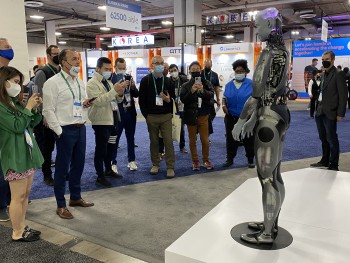Toward the beginning of the COVID era, a private all-boys high school in our neighborhood was Zoom bombed during a guest lecture. There was nothing particularly nefarious about the incident, save that the miscreant student from another institution used the opportunity to share images that most clergy would want sensitive eyes to avoid. After that incident, the school tightened its protocols, including creating more diverse passwords and monitoring remote attendance more closely. Of mistakes from which to take a lesson, this was pretty mild. And it at least brightened the day of several parochial students.
Remote learning during COVID offered a safe haven physically but has been identified as a factor in decreased learning gains among students. I would argue the results are a net positive over the alternative of no learning, but the experience demonstrated that it is not enough to implement technology and connectivity. Rather, the instructional and learning experience must be adjusted for the new virtual environment. This is similar to the questions surrounding the use of teletherapy for treatment of SUDs: There is widespread agreement that remote engagement can be a valuable tool, but professionals are still determining the best approach. And, overall, the general consensus is that in-person encounters are preferred.
Much has been said about the metaverse. Facebook’s recent name change to Meta shot this term into the general consciousness. And yet there is no single definition that confines this idea. Consumer Technology Association VP for Research Steven Koenig offered a useful definition this week, describing the metaverse as the “next generation of the internet that will deliver increasingly immersive digital experiences . . . that will become inextricably linked to our physical reality.” Are we there yet? No. But we are closer than we think. Koenig compared our current position to our perspectives of the internet in the early 1990s when 56 Kbps and “You’ve got mail!” were the pinnacle of technological achievement. We ain’t seen nothing yet.
And this is where it gets interesting, the metaverse and the immersive experience. We have already tasted that with AR/VR capabilities, as well as mind-blowing holographic capabilities. So, imagine for a moment an educational experience where the bulky VR goggles have been replaced by a lightweight unit. (Recall that earlier we highlighted VR glasses from XRHealth that weigh less than five ounces. It took two years to move from the larger VR goggles to the far lighter versions; imagine what the next two years will bring.) Combine the nearly imperceptible equipment with a holographic instructor or an immersive virtual experience, say a tour of recreated history or a science experiment. It’s not so far away – just see the Whitney Houston hologram show in Las Vegas. The Washington Post described it as “technology to tempt mortal physics.”
So, let’s unpack some of the things we’ll need to think about as these developments emerge. First, the possibilities for individualized instruction and “mixed reality.” Students will be able to experience three-dimensional shared spaces across the miles; immersive experiences and holograms will enable students to participate without wearing heavy goggles, and at times without wearing any headset. Adaptability will also enable narrowly tailored applications for specific students or interest. Distance learning has been touted as a bridge for rural students; a metaverse learning experience can place the student into the environment (virtually) instead of endeavoring to bring the environment to the student.
Of course (and as is usually the case with introduction of new technology, as we explored in yesterday’s post about autonomous ag tech) there will be weighty ancillary considerations for educators and school districts. At the outset will be balancing schools’ desires (or mandates) to adopt new technology, and the costs of that new technology. General trends, however, indicate that technology costs are highest for early adopters and over time moderate for later adopters. Technology prices tend to decrease over time as (i) processing power grows exponentially in relatively quick cycles, (ii) ongoing improvements change what is considered “state of the art,” and (iii) increased demand results in higher production, leading to economies of scale that enable lower costs and pricing. So, even if rural schools are not first in the pool, it is reasonable to predict that given the pace of development the time to adoption will not be very long.
The next issue that schools and districts will need to address is safety and security. The construction of a metaverse educational experience will by necessity reflect information about each student or group of students. Locking down those data will be critical. And schools will also need to navigate how to create “walled gardens” in which students can experience new educational resources without straying off the virtual campus to unwanted content.
Device affordability for students will also demand attention. While on-campus venues can be anticipated to support a metaverse experience, students’ ability to re-enter those realms at home will be a critical aspect of enabling a fully accessible educational environment. To be sure, some capabilities will not be candidates for replication outside of school (i.e., where it is neither technically nor economically feasible) but some effort to extend learning beyond campus will warrant exploration.
Finally, user privacy: We already know that if we look at socks on Amazon, we will see ads for socks on Yahoo and Facebook. The metaverse will collect even more detailed and discrete information, and how that information is managed and protected, especially for young users, will be critical. To place things into perspective, AR/VR devices gather eye-tracking data, and that data can be dissected to determine what the user is attracted to, even if subconsciously. Studies show that preferences of the most personal nature can be developed from these data points. Compare this to how we operate in the “real world” – what we disclose to coworkers, friends, family, even spouses – and the imperative to protect privacy expands tremendously.
And yet, the promise is exciting, if not inspiring. Distance education has been touted as a tool for rural areas for years, and COVID revealed its value for those who never had a need to consider it. At the same time, and no different than the application of advanced technology to so many endeavors, our progression toward it will require thoughtful steps to avoid pitfalls of both an innocent and consequential nature. Zoom bombing will seem quaint as we tackle larger issues.


